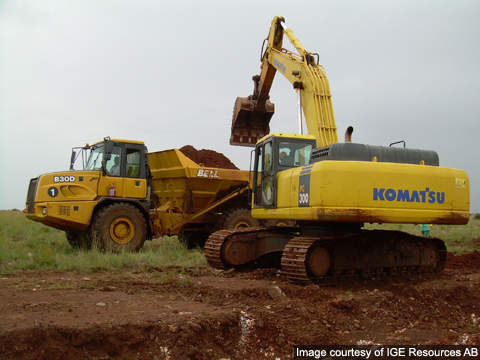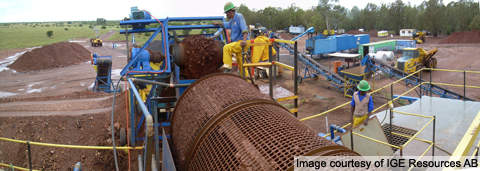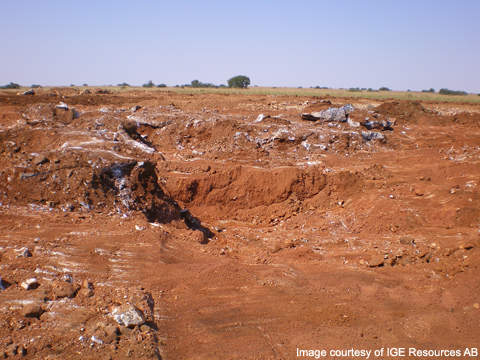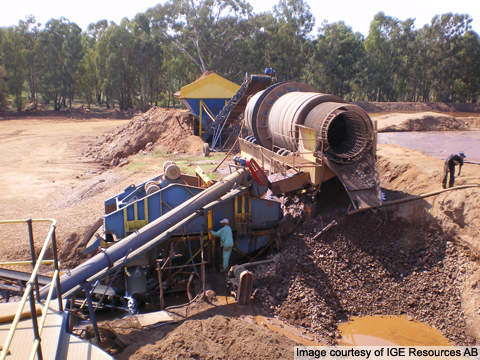The Bakerville Diamond project is located about 20km north of Lichtenburg town in South Africa. The deposit lies within the Lichtenburg Diamond Fields, about 250km west of Johannesburg.
The licence is owned by Innovage Resources (74%), a subsidiary of Pangea Diamonds South Africa (PDSA). The remaining 26% stake is with a Black Economic Empowerment (BEE) company.
The stakeholders of PDSA are IGE Resources (74%) and Panex (26%). IGE purchased diamond interests of PDSA in February 2010. IGE thus indirectly holds 55% stake in the project. It plans to increase the same to 74% by acquiring the entire Panex stake in the project for $2.5m by September 2012.
IGE was granted the mining rights for Bakerville in January 2011.
Bakerville project has five farms in the Patsema area: Welverdiend 361 JP, Ruigtelaagte 353 JP, Houthaaldoorns 2 IP, Uitevonden 355 JP and Zamenkomst 4 IP.
The entire mine is spread over an area of 9.5km². The license area is 168.74km² with another 188km² awaiting permitting approval.
The project is scheduled to achieve full production capacity by April 2013. The development is estimated to cost approximately ZAR90m ($12.47m), of which IGE will invest ZAR67.5m ($9.36m).
Geology
The Bakerville diamond deposit occurs on Transvaal Dolomite, an irregular dolomite bedrock with chert and dolomite. The gravel runs and patches on the alluvial deposit have potholes and large sinkholes of about 70m in depth.
The individual gravel runs are identifiable to several kilometres and are about 140m-wide. The diamondiferous gravel runs are about 3m thick.
The average thickness varies from 1m to 1.5m and is covered by lush vegetation, which prevents erosion.
Exploration
In the 1920s, the declared diamond production at Bakerville area was about 7.5m ct. In the 1980s government surveys indicated the potential occurrence of diamondiferous gravels, which renewed the mining interests in the area.
Prospective properties of the historical area, however, were inaccessible to new exploration entrants until 2004, because of previous South African mineral legislation. During 2008, the Patsema area was largely explored with prime focus on the Bakerville project as the area had potential gravel runs and historical potholes. Bulk sampling was also conducted at the Zamenkomst farm during the same year.
The exploration included the digging of 2,380 hand pits for assessing gravel volume; 20km of trenches for taking 264 bulk samples of about 350m³ to 500 m³; 19, 2.5m Bauer boreholes; and 571 reverse circulation (RC) drill holes.
Reserves
The verified resource base at the mine is 454,000ct with potential for another 579,000ct. The rough diamonds recovered during exploration had an average value of $369.35 per ct. The unexplored pothole structures and deflation surface are yet to be explored.
A pilot mining plant became operational at the site in November 2008. The data collected from the pilot plant was used to assess the development feasibility. The in-house study yielded positive results.
A non-JORC compliant estimated the inferred resources to be 2.17m m³. The average recovered grade for 100m³ was 3.22ct. The bulk sampling plant containing two 16′ pans, scrubber and 20tph DMS with X-ray recovery unit was used to treat about 91,000m³ at the Zamenkomst 4 IP.
The earthmoving fleet consisted of two 30t articulated dump trucks (ADT) and a 30t excavator. The processing plant and the mining fleet are operated by PDF.
Mining and processing
The Patsema area has good road accessibility and electricity is provided by the national grid. Water for mining is pumped from underground.
IGE is currently finalising the mining and processing technology for the Bakerville project.
Operational expenditure is expected to be about $320 per ct of diamond. The mining fleet is planned to be leased to reduce the total costs.
Production
The exact date of production start-up will be based on the currency exchange rate and diamond market assessment in South Africa.
The production is expected to be 2,800ct per month.
IGE Resources signed an agreement with Frontier Mining Projects (FMP) in September 2011 to increase the Bakerville mine’s diamond production and generate cashflows without further investment. FMP will carry out bulk sampling operations from underlying geological formations to finalise the design of two processing plants which handle both potholes and surface deposits.
The first processing plant was commissioned at the mine site in November 2011 for potholes deposits. The second plant with 250,000t capacity will be set up in the next phase to treat surface deposits at an expected rate of three carats per hundred tons.
In December 2011, IGE announced the commissioning of the first phase of the project. Phase one focused on the potholes identified in the license. Recovered pothole material was sent to the processing plant which operated at an average throughput of 120t per hour.
Diamonds recovered between December 2011 and February 2012 were consolidated and sold. The diamonds, however, did not achieve the expected average value of $350/ct. This has led Frontier to reduce its operations at the mine.
IGE is of the opinion that significant amount of pothole material has not been recovered and processed to make a decision regarding the economic viability of the project. It is currently in discussions with Frontier on whether to terminate the contract or carry out bulk sampling to achieve improve economics.








